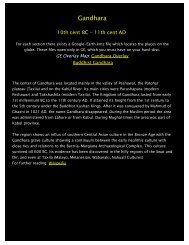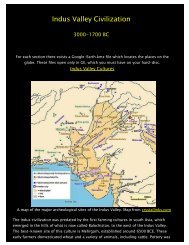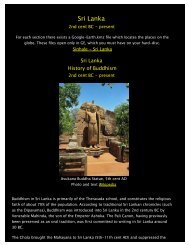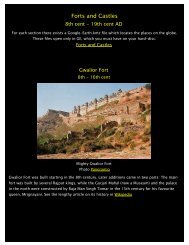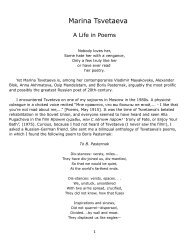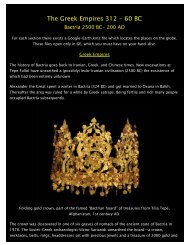On the Way to Arcadia (PDF) - Rolf Gross
On the Way to Arcadia (PDF) - Rolf Gross
On the Way to Arcadia (PDF) - Rolf Gross
Create successful ePaper yourself
Turn your PDF publications into a flip-book with our unique Google optimized e-Paper software.
hours from any inhabited place<br />
Already in <strong>the</strong> second century AD, when Pausanias visited <strong>the</strong> site, <strong>the</strong> temple was neglected<br />
and its four meter-high, precious wood and ivory image of Apollo had been moved <strong>to</strong> <strong>the</strong><br />
market of <strong>the</strong> newly rich city of Megalopolis. Pausanias offers an explanation for Apollo in this<br />
temple that one finds repeated in all text books: The good people of Phigalia, a marketplace six<br />
hours fur<strong>the</strong>r down, had had it built <strong>to</strong> commemorate <strong>the</strong>ir rescue from <strong>the</strong> plague, and<br />
dedicated it <strong>to</strong> Apollo Epikouros, Apollo <strong>the</strong> Savior. However, his<strong>to</strong>rical investigations have<br />
shown that <strong>the</strong> plague of 420 BC never reached Phigalia, and that <strong>the</strong> only epidemic that could<br />
have devastated <strong>the</strong> area occurred much later. Since <strong>the</strong>n <strong>the</strong> archaeologists have been<br />
arguing <strong>the</strong> date of <strong>the</strong> building, and some even dismiss <strong>the</strong> whole s<strong>to</strong>ry including <strong>the</strong><br />
authorship of Iktinos.<br />
I believe, Pausanias <strong>to</strong>ld <strong>the</strong> s<strong>to</strong>ry of <strong>the</strong> plague <strong>to</strong> explain Apollo's epi<strong>the</strong>t Epikouros. However<br />
this may be, Iktinos appears <strong>to</strong> be <strong>the</strong> only architect, who could have designed such an<br />
unusual building.<br />
Among <strong>the</strong> visible inconsistencies is <strong>the</strong> fact that <strong>the</strong> building is oriented not <strong>to</strong>ward <strong>the</strong> East,<br />
as is <strong>the</strong> normal convention, but <strong>to</strong>wards <strong>the</strong> South. Equally unusual and obviously related <strong>to</strong><br />
this orientation, is a door in <strong>the</strong> eastern wall of <strong>the</strong> cella, which, say <strong>the</strong> archaeologists, had <strong>the</strong><br />
purpose of allowing <strong>the</strong> morning sun <strong>to</strong> fall on <strong>to</strong> <strong>the</strong> image of <strong>the</strong> Apollo. But <strong>the</strong>n one<br />
discovers <strong>the</strong> pediment of <strong>the</strong> statue not in <strong>the</strong> center of <strong>the</strong> cella, its usual place, but near <strong>the</strong><br />
wall opposite <strong>the</strong> door. It appears that <strong>the</strong> god had been made <strong>to</strong> look East over <strong>the</strong> mountains<br />
of <strong>Arcadia</strong>, somehow as <strong>the</strong> resolution of <strong>the</strong> entire "wrong" orientation of <strong>the</strong> building.<br />
Certainly a puzzling, seemingly arbitrary design for a great architect.<br />
The unusual position of <strong>the</strong> image has a simpler explanation. We know from <strong>the</strong> sketches of a<br />
19th-century visi<strong>to</strong>r <strong>to</strong> <strong>the</strong> site, that a five meter high column s<strong>to</strong>od at <strong>the</strong> end in <strong>the</strong> center of<br />
<strong>the</strong> cella, precisely, where <strong>the</strong> great images were normally placed, and this column was<br />
crowned by a Corinthian capital, <strong>the</strong> earliest such capital in Greek his<strong>to</strong>ry. The column seems<br />
<strong>to</strong> have had no supporting function in <strong>the</strong> building.<br />
For a deailed discussion of <strong>the</strong> architecture of Bassai see: The S<strong>to</strong>nes of Greece: Bassai (in<br />
German).<br />
It appears that Apollo had <strong>to</strong> make way for an o<strong>the</strong>rwise architecturally useless column. The<br />
first puzzle has been replaced by a second, even more enigmatic one, - or, strange thought,<br />
could this column have been <strong>the</strong> object of veneration




